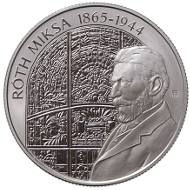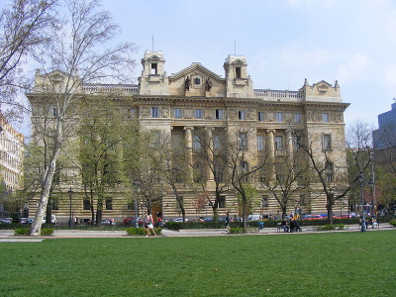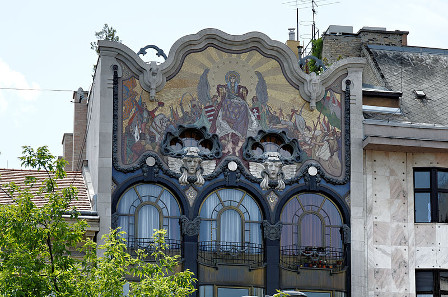November 26, 2015 – Hungary issues a 10,000 forint silver and a 2,000 forint non-ferrous collector coin in celebration of the 110th anniversary of the building of the Magyar Nemzeti Bank as well as the 150th anniversary of the birth of glass painter and mosaic artist Miksa Róth who designed the magnificent glass windows of the Magyar Nemzeti Bank’s headquarters.
Hungary / 10,000 HUF / Silver .925 / 24 g / 37 mm / Design: Zoltán Tóth / Mintage: 5,000.
To mark the Magyar Nemzeti Bank building’s 110th anniversary, the front of the coin presents an interesting perspective on one of the exterior friezes of the iconic building which still serves today as the headquarters for Hungary’s central bank. In celebration of the 150th anniversary of the birth of Miksa Róth, “glass painter and mosaic artist to the Imperial and Royal Court”, the back of the coin features the rich Secessionist-style stained glass windows of the Bank’s headquarters and a portrait, as interpreted by designer Zoltán Tóth.
Magyar Nemzeti Bank, Budapest.
A New Building for the Austro-Hungarian Bank
The Austro-Hungarian Bank was founded in 1878 after the Compromise, and until the turn of the century its Budapest offices were located at József Nádor tér. It was felt that more representative headquarters were needed and thus a tender was announced for Hungarian and Austrian architects, in accordance with the rules of the Dual Monarchy. A building lot where a reviled prison had once stood was selected by the Austro-Hungarian Bank as the construction site (the other half was slated to house the new Stock Exchange). The jury unanimously chose the plans of Ignác Alpár. Unfortunately, no official plans of the rivals remain, only newspaper articles. Even Alpár’s tender plans were only published in 1906 in the periodical “Hungarian Tender Plans”.
The headquarters of the central bank was built between 1902 and 1905, under the direction of István Pucher. Almost without exception, the builders, craftsmen, artists, smiths and master joiners working on the project were members of the Steindl guild, headed by Ignác Alpár. The building’s rich interior work was done by Károly Sennyei, Béla Markup, István Tóth, Ede Mayer and József Róna. Géza Maróti created the interior statuary work, the wrought-iron work was made in the shop of Ede Alpár, and the interior design of the grand council hall (today Lamfalussy-hall) was by Emil Schrödl. The carved doors were the work of Alajos Michl, and the brass lamp fixtures were made by Rudolf Kissling. Differing slightly from the original plans, the building’s stark, robust, monumental façade is a defining element of today’s Szabadság tér, along with the Stock Exchange, which was also built according to Alpár’s plans.
One of Miksa Roth’s creations: glass art at the Turkish Bank, Budapest. Photograph: Yelkrokoyade / https://creativecommons.org/licenses/by-sa/3.0/deed.en
The Glass Windows by Miksa Róth
Miksa Róth was a respected artist of the Steindl guild and was responsible for the main stair hall and the “Art Nouveau” glass windows in the halls. These massive leaded glass windows harmonise perfectly with the Bank’s august interior atmosphere. After World War II, the interior courtyard was built in for functional purposes, and consequently the glass painting symbolizing economy and accounting has been removed, while the remaining stained glass compositions now show their full magnificence with artificial lighting.
Biography of Miksa Róth
Miksa Róth was born on 6 December 1865. His mother and father were both glassworkers and he learned the trade in the family’s workshop. He once said that he had not only learned to love glass, he had learned to respect it as a noble material. He perfected his skills in Germany, France and England, also learning the art of mosaics in Italy. He experimented with the use of eozin-glazed elements by Zsolnay and opalescent Tiffany-style glass in mosaics, patented a special type of cementboard for movable mosaics, and developed the free-contour mosaic technology and the method of creating unlit glass mosaics. His work was initially influenced by Historicism, and later by the Secessionist school and art deco (combining these).
In 1885, Miksa Róth founded his “independent glass painting art institute”. In addition to the grand mosaic windows of the Magyar Nemzeti Bank, his works are also found in the Parliament building, the Gresham Palace, the Music Academy, the National Archives and at the Benedictine Abbey of Pannonhalma. One of his most important foreign projects was the glass cupola of the Teatro Nacional in Mexico City.
Information on this and other releases is available at the site of the Magyar Nemzeti Bank.
Here you will hear more about the Miksa Róth Memorial House and glass museum in Budapest where you can also watch a movie showing many of Róth’s creations.








